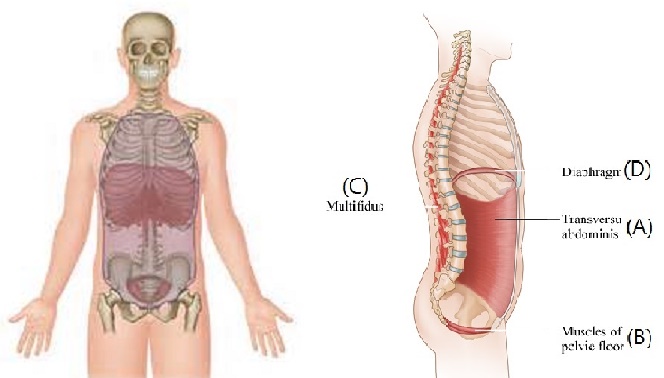Either the chronic static postures that we maintain throughout the day or repetitive bending, twisting with loads or unload are susceptible for back injury. Having a good conditioned deep trunk muscles to stabilize the lumbar spine can help us prevent injury.
The primary role of the abdominal muscles is to provide isometric support and limit the degree the trunk can rotate. Most of the low back problems arises because they fail to maintain tight control over the twisting action at lumbar spine. Over focus on isolated training for appealing abs such as crunches works against its functionality.
It is crucial to hold the lumbar spine in the neutral position, which is the correct alignment of the pelvis that allows for the natural ‘S’ curve of the spine. To stabilize lumbar spine are those highly endurance muscles in deeper layers collectively called the deep trunk muscles. They are transversus abdominis (TA), multifidus (MF), diaphragm, and pelvic floor (image on the right). The co-contraction of these muscles primarily “stiffens” the spine, generates hoop tension through the thoraco-lumbar fascia and increases intra-abdominal pressure to stiffen the trunk during movement.

The deep trunk muscles act as stabilisers working at a low level of contractions. They are “switched on” all day long guarding against unwanted motions and promote good posture. Some studies find out there is co-contraction of the deep trunk muscles prior to any movement of the limbs. This neurological response is critical to stabilize the spine before external forces act on it.
However, damage of the abs muscle fibre due to surgery, poor diet may inhabit this response and put spinal stability at risk. The most common factor is chronic tension or pain arising from poor postures. This may induce compensatory movements which further increases the mechanical stress on joints, and soft tissues, in return, pain becomes more severe. To restore the function through conditioning exercises of abs muscles is hopeful to stop the cumulative pain cycle.
The priority of core training is to condition the deep trunk muscles so that they can continuously hold the position of the lumbar spine during dynamic movements. Instead of strength, train for its endurance is more functional as opposed to most typical abs exercises do. To promote these deep muscles to coordinate correctly, proper deep breathing pattern is necessary. (Further reading: A step-by-step approach to strong core)